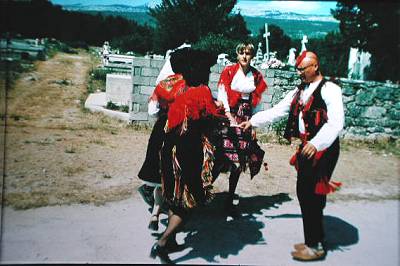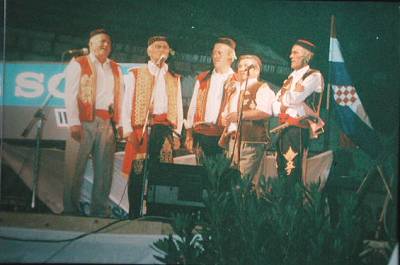Singing on a dernek does not mean a solo performance in front of an attentive audience. On the contrary, singing of more groups at the same time, more diple (14)players around kolo [a mute round dance] is a socially tolerated concept . In this context the strongest, loudest and mightiest singing gets the most attention.
Not until the 1990’s surges a need for a public stage which presumes a performance of a group whose singing is evaluated by the audience according to the same principle - the louder the better. Public events are organized in the spring and summer months with or without a cause, regularly on a weekend, in order to draw more visitors. Such events are still held on the Patron Saint’s day (or on the nearest weekend), but they have an extremely mundane character. The most famous event of this type is the Ganga-fest in the village of Biorine near Imotski . The organizer of this encounter is the local inn-keeper, who, having the exclusive right of selling food and beverages geartly consumed during the event, earns enough money to cover the expenses and to give out awards. The event is based on the model of dernek (15) and popular music festivals, which are held in nearby coastal towns (Split Festival). The central point is a stage decorated by sponsor posters, with lights and powerful loudspeakers used to play diverse popular music during the breaks. The event, advertised in the media, is of competitive character in sports (throwing of a rock, hand wrestling, sijavica (16)) and musical categories. Singers and players, besides during the main performance on stage, like on the ancient dernek, sing off stage, alongside with other groups. There is a professional host and a jury, composed of vidjenijih ljudi ["known" people].
The main program is
"enriched" with best traditional costume
contest, beauty contest and a fashion show. The
competition goes on in several categories - ganga,
rera, ojkavica, treskavica. All contestants who
have applied are allowed to perform, regardless of the
sex, age and composition of the group. The audience has the central role in electing the best singers - they react to the performance by applauding and screaming. Ganga-fest is being held for the fifth time this year. In the meantime similar events are being held in other villages, with more or less success . The interest of the audience for fighting and competing has motioned the organizers to include bullfights into such events.
The performances of organized folklore groups are not rare in this type of events. The phenomenon of folklore festivals is an invention of Croatian tradition, known since the 1920’s. "The folklore festivals are a ceremonious, ritualized, structured, stereotyped event, which precisely by being formalized connotes the value, the importance and then also the pleasure of the organizers and performers" (Ceribasic, 1998:13). The performances of groups from Dalmatian Hinterlands always draw attention with their "authentic" styles of singing, music making and dancing. After the end of the Homeland War, in this area the trend is increasing of organizing a greater number of such groups, especially in the war-stricken areas, and some of them (from Vrlika, Kijevo, Polaca) have even as refugees performed in an organized way, identifying themselves by performing as a personal identity. Through the work of organized folklore groups it is possible to keep even the older genres (samacko, treskavica), which are rarely performed in public practice. The folklore festivals such as the International Folklore Festival in Zagreb and the Dalmatian Folklore Festival in Metkovic are places where the approach, the work and the progress of certain groups can be monitored. It has been noticed that many folklore groups nowdays base their most "authentic" repertoire on the audio recordings of their predecessors (17) . The insufficient media coverage affirms a general attitude of the society towards this kind of musical practice. The announcements of public events (bull fights, Ganga-fest) and reports of the folklore groups performances are rare moments dedicated to this kind of musical practice by the Croatian media. The attitudes of the primitiveness of this music, which have been inherited from the socialist system, are now a bit milder but are still far from being accepted. The term "their" music (18) instead of "our" music is still very common. The insufficient media coverage results in no publishing production. The publishing cassettes or CDs is very rare, and they are mainly privately produced. In order to promote themselves, some individuals are prepared to make a lot of effort and invest a lot of imagination in the promotion. I have personally had the chance to buy a 90 minute cassette tape of an older diple player from the outskirts of Drnis, which he has recorded himself using his own cassette player and was selling the tapes himself and demonstrating the playing, commenting that the price (50 kuna, approx. 6 US$) is appropriate for his effort. The gusle songs, the recordings of which are the most wanted ones, can usually be found on the illegal market on fairs and public events. Radio and television have brought to this area new musical genres and the repertoire of popular music. By taking over new models of popular (tempered) and traditional singing (pjevanje na bas - perfect fifths endings), different musical worlds are going on parallely, but have no direct influence on the musical values of the traditional culture. The existence of several musical worlds leads to the need to emphasize the personal affinities. The best example has been provided by a fruit and vegetable merchant, who, after having lost the job in the town, came back to the village, selling the same products in his van, announcing his coming by loudly playing rera and ganga. His comment that "people like our music, and therefore they buy more" confirms that even today, in the age of progressing globalization, musical systems, such as in the Dalmatian Hinterland, instead of disappearing, survive by finding out new modes of existence. |



